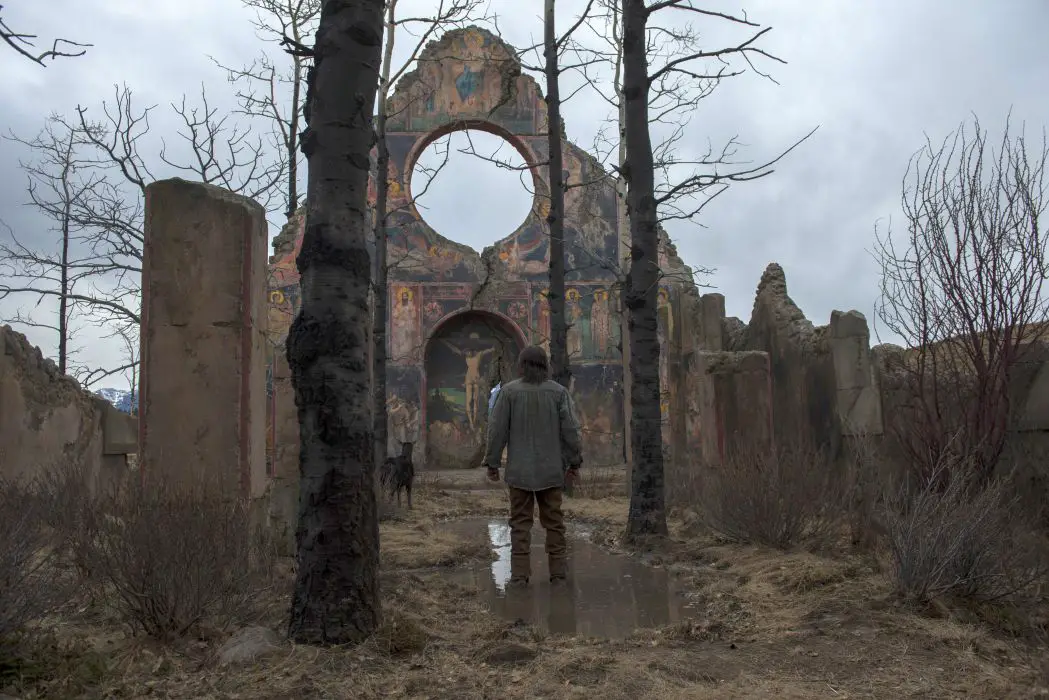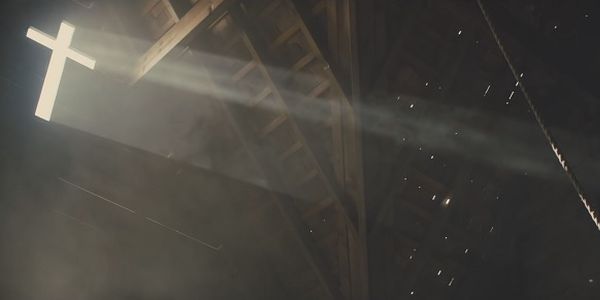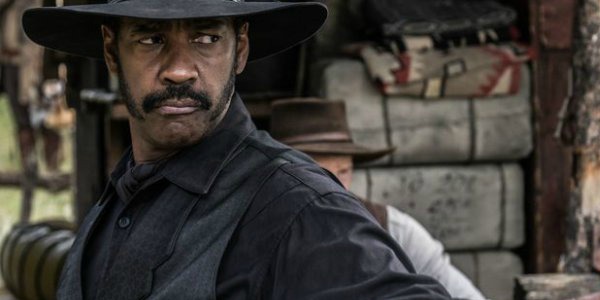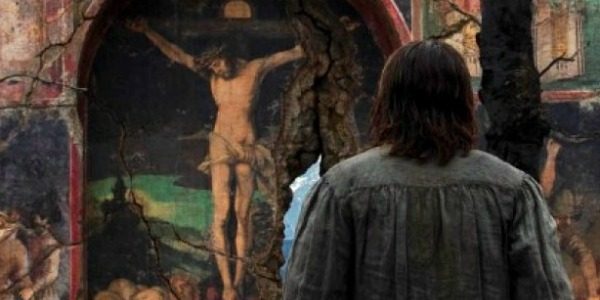Gimme Shelter: The Role Of Churches In Film

Based in Belfast, Neil Sedgewick blogs over at filmsandfaithblog.com where…
Over the last twelve to eighteen months I’ve noticed a trend. It’s very small and many would say insignificant but I’ve been fascinated by the number of times filmmakers use churches in film – take us into a church setting. The question is why do this?
Whether bathed in the light of stained glass or under the gaze of a crucifix, there must be a method or reasoning behind this decision. While ‘faith based’ films such as God’s Not Dead use elements like this as an evangelical tool, I’m not convinced that all filmmakers wish to be so blatant in their use of worship spaces.
Throughout the course of this article I will pick out some of my favourite examples I’ve noticed in this trend and examine the possible reasons for their inclusion.
Contemplative space
Justin Kurzel’s Macbeth is a visual feast. Its slow motion battle sequences and the steely glare of Michael Fassbender in the lead role are enough to give the film glowing recommendations. Never mind Marion Cotillard as the bewitching Lady Macbeth and the film dazzles as it weaves its way through the familiar tale of the conflicted king.
Within the film’s first movement we see Macbeth enter the basic church structure of his village to wrestle with his takeover plan. The seeds of the plan have been planted and it is the church in which he makes his decision. During these moments we watch Fassbender wrestle, ponder and sweat his way to his conclusions. In prayer, in contemplation and in turmoil he decides his fate and accepts his destiny. This sequence stood out to me as while he wrestles the light surrounding him comes into play.

Etched into the sides of the wooden worship space are crucifixes acting as windows within the primitive structure. The light from outside pours in and as Macbeth rocks back and forth. His moment of clarity comes as he sways in and out of the light of the cross, the ultimate sign of sacrifice.
Kurzel at this point is doing two things in using the church as location. In this moment the church signifies a place of wrestling, intense thought, contemplation and a space that provides clarity for Macbeth. Regardless of whether or not the viewer considers his actions just, the location is the significant factor at this point. This is in fact Macbeth’s Gethsemane moment: The moment in which fate is accepted and he leans into the darkness that will soon engulf him.
Regardless of how you view Macbeth’s decisions it is within these walls where he finds justification for his actions imagined or otherwise.
House of Justice
Antoine Fuqua’s Magnificent Seven is by no stretch a great film. Enjoyable in parts and laborious in others it can probably best be described as a mixed bag. However, it does spend considerable time, for a mainstream blockbuster, in church.
The film opens with a town hall-style meeting, discussing the plight of the settlement and the impending show of force by capitalist bully Bartholomew Bouge (Peter Sarsgaard) and his band of hired thugs. This is significant as the church fulfils a function here as not only meeting space, but also as a neutral space where opposing views are freely discussed and respectfully dismissed without major conflict (at least, until Bogue appears).
This is not, however, the only function of the church in this film.

The final confrontation between Bogue and Chisolm (Denzel Washington) takes place within the walls of the church. Underneath the gaze of the cross these two battle back and forth both in pursuit of their version of justice. Neither of these individuals are ‘good guys’ as both display questionable morals in their roles, as bully and bounty hunter respectively. These moments, however, highlight the church’s role in distributing justice. Old Testament prophets have long cried out for justice and it is the responsibility of the church as a body to oversee its implementation.
Given the redirection of this incarnation of The Magnificent Seven, aiming its guns at the relentless takeover of capitalism rather than Mexican bandits, it could also be argued that the church is being used as the last line of defence against an encroaching force of worldly wealth and power.
Bogue is in pursuit of the towns assets and cares not for principles of the people or their lives. By taking their last stand at the church the townspeople are basing themselves at the biggest symbol of where their beliefs are held. It is the place where they don’t necessarily retreat to, but the place that provides the with the best form of protection and shelter.
Shelter
One of the films that has stayed with me throughout 2016 is Alejandro G. Iñárritu’s The Revenant. The film has a spiritual core that intrigues me, and, to be honest, I’m still not 100% sure what it’s all about. I’m still contemplating one scene in The Revenant, above all others. I wonder at the director’s reason for its inclusion and try to work through the scene’s intention.
The scene I’m referring to is the point in the film in which Glass (Leonardo DiCaprio) enters the crumbled edifice of a church. This dilapidated structure has suffered, even in these early days of civilisation, but its foundation and structures remain. In fact, within the fading church there is life as trees have put down roots bringing new life and growth.

Initially, I thought the use of the church was simple. The church at this point is used for shelter. Even in its dilapidated state it still provides a level of shelter form the relentless frontier that Glass has survived and crawled his way through. That may be the only intention, but as the scene progressed something else grabbed my attention.
While Glass stands in the church ‘grounds’ he stares at the picture of Christ on the wall, depicted at his crucifixion. At this point, my eye was drawn not to Christ on the cross but the gap in the wall. This gap is significant because this gap allows entry and exit simultaneously. I would guess that its location is not accidental either. It is not just the gap in the wall, but the cross itself that can be identified as both entrance and exit to the church.
Those who enter find shelter here. Those who enter find signs of life they may not expect. Those who enter can rest from the constant battering of their surroundings. Those who enter can stay as long as they need to. However, the same can be said for those leaving.
Those who exit are ready to take on the next stage of the journey. Those who exit have sheltered, recovered and found life in its fullness. Those who exit may see a bigger picture and possibly a new frontier. Those who exit may be ready to move outside of the structure, the confining walls and move into some bigger, greater and explore something new.
Perhaps the commentary being applied by the director here is that while the foundations and the gap in the wall remain, help for those on the way in and those on the way out of the church structure exists.
Take Me To Church
It is clear that churches in film perform many functions: shelter, respite, centrality, meeting ground and place of contemplation and resolution. All have their place within the sacred walls and there are many more aspects that I have not explored here.
The films I have cited are a few recent examples, and these interpretations of how these churches have been used on film, are my own. Cinema history, though, is littered with great church sequences.
I would love to know: what are your favourites? What is it that makes them stand out and why do you think they have been included?
Does content like this matter to you?
Become a Member and support film journalism. Unlock access to all of Film Inquiry`s great articles. Join a community of like-minded readers who are passionate about cinema - get access to our private members Network, give back to independent filmmakers, and more.
Based in Belfast, Neil Sedgewick blogs over at filmsandfaithblog.com where he examines film through the lens of faith in an attempt to deliver some cinematic theology to readers. Neil is also a regular contributor to banterflix.com appearing on both their podcast and TV show.













